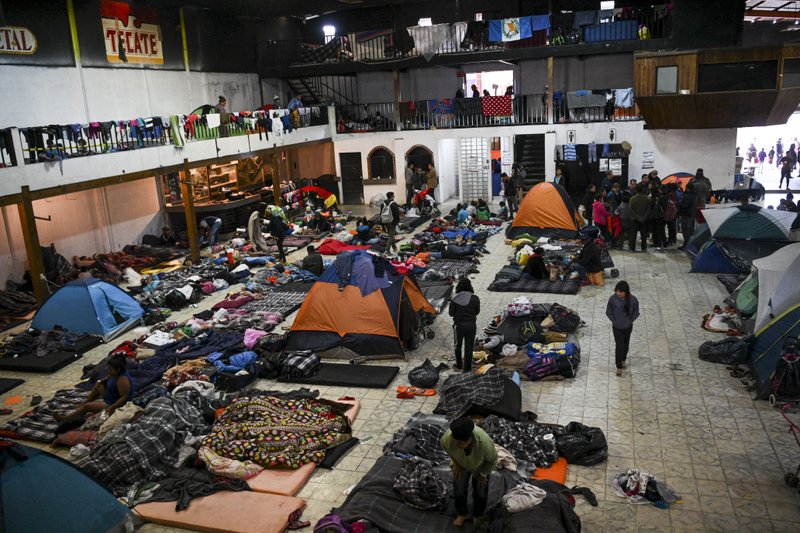The United States on Tuesday returned a Honduran asylum seeker to Mexico, marking the beginning of a new policy that forces asylum seekers to wait in Mexico as their claims are processed in American courts.
Homeland Security Secretary Kirstjen Nielsen planned to visit the San Ysidro port of entry later Tuesday to "assess implementation" of the new regulation, according to a Homeland Security Department statement.
The policy is an attempt by President Donald Trump's administration to deter migration by reducing the number of migrants who live and work in the United States while awaiting their court dates.
Already the plan has raised numerous human-rights concerns and logistical questions that neither the United States nor Mexico has been able to answer. Where will the asylum seekers stay in Mexico for months or years as their cases are processed? How will Mexico ensure their safety? How will they access legal assistance?
Even the program's start has been chaotic. The Mexican Foreign Ministry initially said Friday that it expected the first group of asylum seekers to arrive within hours at the San Ysidro port of entry near San Diego, even though the immigration agency said it had received no formal communication from the United States. There were no official U.S. guidelines until this week.
And the return of the Honduran asylum seeker Tuesday appeared to be ad hoc. He was rushed to a van by a Mexican immigration agent with no formal announcement of when others would follow. Rodulfo Figueroa, the national migration agency's representative in Tijuana, said no others would be released Tuesday.
The Mexican government has said repeatedly that it disagrees with the policy, which officials argue is being imposed on the country by the United States. Tonatiuh Guillen, the commissioner of Mexico's immigration agency, said Monday night that Mexico would admit only Central Americans between the ages of 18 and 60 as a part of the new policy. Because a large portion of asylum seekers are family units or unaccompanied minors, the Mexican response could erode the potential impact of the new policy.
The asylum seekers forced to wait in Mexico will be given multi-entry permits to attend their court dates in the United States and then return to Mexico. Some asylum seekers have Mexican humanitarian visas that are valid for one year. After a quick initial processing at the border, migrants will have a hearing in 45 days and a decision within a year, according to Homeland Security.
U.S. officials said they would screen the asylum seekers to ensure that people at risk of persecution in Mexico are not told to wait across the border. But lawyers remained concerned about how the United States would make that determination.
Mexico's northern border includes some of the country's most dangerous cities, where migrants are often extorted or kidnapped. Implementing the new U.S. policy there, human-rights advocates say, would likely have tragic consequences.
"We have worked with people who are under active threat here in Mexico who have had to move between shelters and stay in secret locations because they are being actively pursued throughout Mexico, and throughout Tijuana. This is literally sentencing people to die," said Nicole Ramos, an attorney with the Tijuana-based legal aid office Al Otro Lado.
The city's resources are already being stretched by the scores of migrants who have arrived in recent months. There are already about 2,400 people who are waiting in line for asylum, a product of the U.S. system known as "metering," or limiting the number of asylum seekers who can begin their cases each day. The first members of the newest migrant caravan arrived in Tijuana in recent days, with thousands more apparently on the way.
Some of the city's shelters are already nearing capacity, housing a steady stream of migrants from across Mexico and Central America and others who arrive from countries around the world to make it to the U.S. border. The emergency shelter that had been opened to house thousands of people who arrived from Central America in a caravan in November was scheduled to close this month.
Mexico's new president, Andres Manuel Lopez Obrador, promised a more humane response to migration. At times, his administration appears to be delivering. When the new migrant caravan crossed into Mexico, for example, the government issued many of those migrants humanitarian visas, allowing them legal entry into the country. But Mexican officials have expressed concern about their ability to provide a comprehensive humanitarian response to the new U.S. policy.
Gustavo Magallanes Cortes, the director of migrant affairs for Baja California, said Monday that he feared that federal budget cuts this year -- of about $1.2 million in Baja California -- to a migrant assistance fund had left small shelters scrambling for resources.
"They open the northern border, they open the southern border, but then they close the funds to help us," Magallanes Cortes said.
A Section on 01/30/2019
